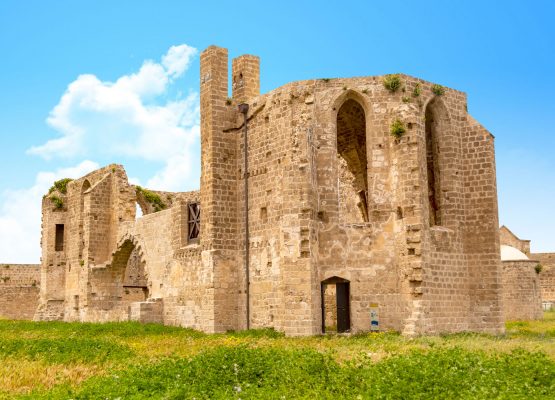
Characteristic of Mendicant Orders
Another of Famagusta’s remarkable Gothic-era ruined churches is the Church of St. Mary of Carmel or the Carmelite Church, found in the north west corner of the city.
Located in the bastion precinct, the church of St. Mary was one of the city’s larger edifices.
In the 13th century, as Muslim armies gradually reclaimed the Holy Land, many middle eastern Christians fled to Famagusta. Although Christian, their specific beliefs differed from that of Latin or Orthodox Christians, and they tended to congregate in the same area.
In a letter dated 13 March 1311, Pope Clement V authorised the Carmelites to settle in Cyprus. Two other mendicant orders—the Franciscan and Dominican orders—had already been established in the city for fifteen years or so. The Augustinians, the last of the mendicant orders, arrived shortly after.
The Carmelites who originated from the Carmel mountains of Northern Israel found themselves in a district of Famagusta which later became known as the Syrian quarter of the city.
The church was built in the 14th Century as part of a monastic complex dedicated to the Virgin Mary, hence its name St. Mary of Carmel. Indeed, many other churches were built in the town at the same era, and chroniclers believe Famagusta to be one of the richest cities in Christendom.
It was close to a corner of the urban enclosure where the Venetians would later build the Martinengo Bastion in the sixteenth century. It adjoined the Armenian monastery, which was established at the same time, and was next to other monasteries belonging to eastern communities with whom the Carmelites traditionally maintained a religious dialogue.
Located in an area provided by King Henry II who reigned between 1285 – 1306 and 1310 – 1324, evidence of royal participation, the kingdom’s coat of arms and that of the Lusignan family can be found on the façade of the church. A keystone on the ground bears the same coat of arms of Cyprus.
Another keystone bears the coat of arms of the Babin family, a powerful family in the kingdom who had donated generously to the monastery, and the remains of this family’s’ epitaphs were also found during archaeological excavations.
The wall-niche tombs testify to the popularity of the mendicant orders amongst the faithful, who wanted to have their final resting places in their church.
The plan of the Church of St Mary of the Carmelites is characteristic of the beautiful simplicity of the mendicant orders – a single nave of three bays that terminates in a five-sided hexagonal apse. This plan is almost identical to that of the Franciscan St. Francis Church, which was built slightly earlier and today is aesthetically less severe.
The monument’s outline does in fact give it an extremely austere appearance – the walls, which are without interest and have no decorations, are supported by buttresses without projections. Only the façade, which opened onto the street and therefore faced the city and the faithful was richly decorated, featuring a large pointed window with tracery.
In its day, St. Mary was an important church – the tomb of Peter Thomas, a Carmelite friar recognised as a saint by the Roman Catholic Church, who was the Pope’s representative and the Patriarch of Constantinople, died in 1366 and was buried here.
The austerity of mendicant architecture also spread to other religious edifices – the neighbouring Church of St. Anne was built in a similar style to this Carmelite church.



